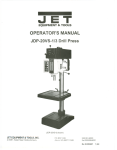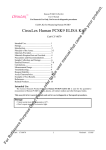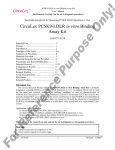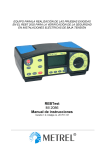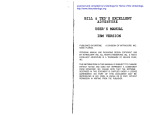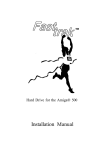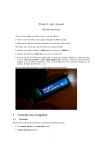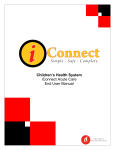Download Review (Ahoy, Sep 1986)
Transcript
>i=vn=w<t r Wk I---------------------------- 1 THE SPARTAN Top: inside the Spartan , with the CPU and Apple drive cards installed. The 1541 shows the custom DOS card installed. Mimic Systems, Inc. Commodore 64 Price: $299 After being heavily advertised for over two years, the Spartan from Mimic Systems seemed destined to become the longest recorded case of vaporware in microcomputing his tory. It lost its chance at this dubi ous distinction in May when, to our surprise, a prototype of the Spartan arrived in our New York offices for review. What turned out to be an even greater surprise was that the darned thing actually worked! This was no mean feat considering the number of distinct pieces of hardware which had to be fitted together. However, we seem to be getting ahead of ourselves. For those of you who may have just come on board the ship of Commodore computing, or for those individuals who missed Mimic Systems’ full page color ads in nearly every issue of Ahoy! through last November, we state the follow ing: The Spartan is a hardware de vice which bestows upon your Com modore 64 the ability to emulate an Apple 11+ microcomputer. Note that we said 11+ and not lie or lie. The Spartan is not designed to provide the extended features of these later models. So what’s this, we hear you say? Why should anyone running a C-64 be interested in an itinerant fruit ma chine? Don’t we C-64 users already enjoy access to possibly the largest library of quality software available for any microcomputer? To these skeptics in our audience we simply say that it is not our in tent to indulge in philosophical dis course, nor will we attempt to influ ence anyone’s religious beliefs. We will merely present the facts as they are. After all, our ears still ring from those plaintive cries of fledgling C64ers: “Is there any way to run Apple software on my computer?” (We have occasionally heard the opposite motif emanating from many a fruity source.) SEPTEMBER 1986 Ilf* Besides, at the new price of $299, the Spartan sure offers a lot of fancy hardware. The Hardware When it comes to hardware, the Spartan definitely sports some unique features among its several com po nents. The heart of the system is a boxy looking affair styled very much like the C-64. In fact, once installed, the Spartan seems to fit naturally in place. This 12” deep by nearly 5” high C-64-gray plastic container is exact ly the same width as the 64. The top surface of the box, which is easily re movable to allow for internal access, is the right size and of sufficient structural strength to support a 1702 color monitor. Inside the box is the system’s main circuit board, or BUSS Card, and a 60 watt peak switching power supply. Mating the Spartan to the C-64 is straightforward - just gen- Bottom: bird’seye view o f inte rior. To the left is the power sup ply. The main circuit hoard, or BUSS Card, dis plays its array o f Apple peripheral slots at the back (top) and three C-64 internal ex pansion ports at the front (bot tom) right. The large chip with the yellow dot (center right) is the custom com munication chip. tly ram the Spartan into nearly ev ery orifice in the back of the C-64. The BUSS Card itself has rigidly positioned mating connectors for the C-64’s user, cassette, and expansion ports. Flexible hookup cables are provided for the serial and video ports. The only port left unmolested is the television connector, for which you optionally install the cable orig inally supplied with the C-64. Once mated, the various and sundry connections seem to create a remark ably firm union. The top lid of the main enclosure is easily removed to reveal a very Ap- z plelike environment. The most obvi- 2 ous feature of the enclosed BUSS s Card is a row of nine edge card con- z nectors (known as slots in the Apple s world) suitable for standard Apple s peripheral cards. As the Apple ex- " perts in our audience know, Apples § are normally equipped with only * AHOY! 63 Top: the heart o f the Spartan is its CPU card. The large rectangular chip is the 6502 microprocessor running at one megahertz. The eight kilobyte ROM is identi fie d by the green dot. The two multipin square chips are custom LSIs. The upper performs the Spartan’s video management. The lower han dles memory management. Eight socketed, 64 kilobit dy namic RAM chips comprise the Spartan’s memory. The empty socket is fo r expansion ROM. Middle: The 1541 disk drive’s custom DOS card, which turns the 1541 into an Applecompatible drive. Bottom: The 1541 with the custom DOS card installed. eight slots. The leftmost connector, designated as Slot A, is reserved for the Spar tan’s CPU card. The CPU card con tains its own 6502 m icroprocessor (running at 1 megahertz), 64 kilo bytes of RAM , 8 kilobytes of ROM, and a collection of support com po nents. Among these chips are a pair of Mimic Systems’ proprietary LSIs. These handle the video and memory management of the system. The remaining slots (0 through 7) are for use with various and sundry Apple peripheral cards. One of these 64 AHOY! slots will be immediately filled by an Apple disk controller card. This card, included with the Spartan package, is needed to control the Apple disk drives. The one provided with our unit was made by M icro-Sci, a wellknown supplier of Apple peripherals. As a rule, Apple disk controller cards can each handle up to two disk drives. As with the C-64, the bulk of Ap ple software is disk-based. If you haven’t guessed it by now, the Apple disk format is as unique as the Com modore disk format in the microcom puting world. This means that Com m odore disk drives and Apple disk drives cannot read disks which were formatted for each other’s system, right? Wrong! Mimic Systems was not about to let trivial obstacles of this sort stand in their way. An essential part of the Spartan package is a specialized DOS card which installs in the 1541 disk drive. The installation is somewhat cumber some. The drive's cover and internal RFI shield are removed. The DOS card is installed in the top of the drive cover, where it is held in place by four sticky feet. Next the 1541’s con nectors to the drive’s motors and write protect sensing circuits are transferred to the DOS card. A supplemental set of jum per cables are then used to re connect the 1541’s connectors to an al ternative set of pins on the DOS card. After all this, the drive cover is sup posed to be remounted on the disk drive. We decided not to take a chance on this last operation. The wires making up the jum pers on our sample were of a heavier gauge than what is usu ally employed for this application. This was apparently due to a mixup in the hardware specification of the early units. We decided to operate the drive with its cover standing to the side. Getting back to the Spartan’s BUSS Card, we noticed numerous jumpers, connectors, and test points scattered about. Unfortunately the preliminary manual with our system did not con tain the information needed to prop erly identify these parts. A far more detailed technical manual for the Spartan is in the works. We did manage to locate the Spar tan’s firmware in ROM. The biggest chunk consists of a 16 kilobyte sys tem ROM which contains a clone version of Apple floating point BASIC, monitor, and autoboot rou tines. This package was written for the Spartan by Central Point Soft ware, a major developer of Apple programs. Alongside is an eight kilo byte Spartan Phantom ROM which presumably handles the C-64 com munications on the Apple side of the setup. There is also a corresponding eight kilobytes of C-64 ROM for the REVIEWS Top: front view o f Spartan. Middle: back view, showing four DIN connec tors, extensions to the C-frfs cassette and user ports, power connector, and on/off switch. Vertical slots are to permit exit o f Apple peripheral card cables. Bottom: right side, sporting fourth cart ridge slot and three reset pushbuttons. C-64 side of things. It is worth noting that the Apple disk operating system (DOS) must be loaded from disk into 12 kilobytes of the system’s RAM. The task of con trolling the drives falls to the 6502 microprocessor in the computer. By com parison, the Commodore disk drives have their DOS in ROM and their own 6502 microprocessor. The C-64 merely issues instructions to the drive which then takes virtually in dependent action. The second most obvious piece of territory on the BUSS Card is the col lection of no fewer than three C-64 cartridge connectors at the front right corner of the board. A close look re veals a fourth cartridge connector ex tending through the right side of the case. The Spartan lets you install up to four C-64 cartridges at once. Any one of these may be selected and ini tialized directly from the C-64’s key board. AHOY! 65 a separate, optional monitor dedica ted to what’s on the C-64 display screen. The next jack is the Commo dore serial port for disk drives, print ers, and other serial bus peripherals. The C-64 power supply plugs into the next jack. Only the nine volts AC from this supply is used, as the C64’s five volt power is supplied from the Spartan’s built-in supply. The in nermost DIN jack outputs mixed au dio and video from both the C-64 and the Spartan. The significance of this last feature will be described in de tail below. The Spartan even adapts Atari- or C-64-type joysticks for use with Ap ple software. The Apple and Atari style joysticks are fundamentally dif ferent beasts. The former arc of an Top: Spartan display of the kaleidoscope analog design bearing a strong resem program included on the Apple DOS 3.3 blance to a pair of mechanically disk (not included). Bottom: the Apple cross-linked paddles. The latter are I l + ’s seven colors a la Spartan. of a digital design composed of four normally open contacts which may Right above these slots is an empty be closed singly or in pairs by mov integrated circuit socket. This is in ing the stick diagonally. Thus Apple tended for a custom ROM chip to act joysticks may be used to impart quan as a replacement for the Spartan’s titative as well as qualitative informa built-in 8K Phantom C-64 startup tion. ROM. In effect, this represents a fifth In practice most games utilize only (or sixth) C-64 cartridge position. Se the directional information imparted lection between this socket and the by the Apple joystick. For these ap Phantom ROM is via internal jum p plications the Atari style joystick may ers. be successfully substituted. The only The Spartan’s rear panel is quite limitation is that Atari style joysticks busy territory. There is the usual have only one fire button to the Ap power connector and on/off switch. ple’s two. The Spartan’s BUSS Card (When will microcomputer manufac is equipped with a standard nine-pin turers learn to locate power switches game connector. This connector is where we can reach them?) The C-64 activated by installing a short jum p cassette port is also brought out to the er between the CPU and the BUSS back panel, along with the C-64’s us Card. er port. The Spartan may be set to Aside from the on/off switch, the use a Commodore cassette recorder only external controls on the Spar to save and load Apple programs. tan (other than the C-64 keyboard it The standard audio jacks, which are self) are a set of not one, not two, but present on the Apple 11+ for cassette three red reset pushbuttons all in a use, are not in the Spartan. However, row on the right side. The rearmost there is a row of test pins on the of these is functionally equivalent to BUSS Card which may be fitted with the RESET key on the Apple’s key an audio adapter. This accessory is board. The middle button resets both available separately from Mimic Sys the Spartan and the C-64 when it is tems. running a cartridge-based program. O ff to the side is a row of four cir The front button resets only the C-64. cular DIN jacks. The outermost jack carries through the C-64’s audio and What It All Means video signals. This lets you hook up The designers of the Spartan have 66 AHOY! exercised their ingenuity above and beyond the call of duty in designing the Spartan-to-64 interface. Num er ous contingencies have been consid ered and accounted for. A closer look at the operation of the system is in structive. The Spartan is a complete micro computer lacking only a dedicated keyboard, which the C-64 provides. In fact the concept of using the C-64 as a keyboard is fairly easy to imple ment. The C-64’s keyboard is nor mally scanned 60 times a second by the Commodore operating system. It does not require much effort to change the destination of any collect ed keystrokes. This means that for the most part neither the C-64 nor the Spartan need be terribly concerned about each other’s presence. As a result the two computers op erate independently of each other. It is entirely possible to boot up and run an application on the Spartan, switch to C-64 mode, and load and run a Commodore program. The operation of the system is guided by an 8 kilobyte C-64 Phan tom ROM in the $8000 block of the C-64’s memory space. As with any other C-64 cartridge, the Phantom ROM takes control of the computer on power up. The power up screen FOR C-128 USIiRS: We haven’t tried this ourselves, but the Spartan may work with the C-128 as well. The physical ports may have to be modified slightly to insert the Spartan into the 128. It appears that the cassette port connector will have to be removed or bent out of the way, which means that the cassette access at the back of the Spartan will cease to exist. However, at this point, the connectors to the user port and ex pansion port should fit properly. The C-128 will then power up in C-64 mode and the Spartan should func tion as described in this report. The remaining problem is to figure out how to plug the C-128’s square pow er connector into the Spartan’s C-64style round port. This boils down to the classic problem o f inserting a square peg into a round hole. READER SERVICE INDEX REVIEWS may be either the Spartan or C-64 display, as selected by setting a jum p er on the Spartan’s BUSS Card. Re gardless of the initial display, both computers go through their initializ ing routines when the power is turned on. Thus the Spartan’s disk drive will whir and chatter and accept and run an Apple application even while the C-64 is busy displaying its opening message. The primary function of the Phan tom ROM is to determine which computer will receive the keyboard’s output at any given time. The user selection controls are built into the C-64’s function keys, which remain active in all modes. The most fre quently used keys will be f2 and f4. The f2 key brings up the C-64 dis play and transfers the keyboard data to the Com modore 64. In this mode all C-64 functions may be performed. The f4 key returns the m achine to Spartan mode, where the Apple takes over. The f6 key executes a C-64 re set, leaving the Phantom ROM mapped in. The f8 key resets the C64 to its power up state without the Phantom ROM. This last function does not terminate the execution of any programs which may be running in the Spartan at this time. Finally the fl key disables all the function key functions for one keypress. This lets you access the function keys for C64 programs which use them. If you use the Spartan’s mixed vid eo port, then the display will auto matically switch between modes. It is also possible to obtain a perman ent Com modore display by hooking up a second monitor to the C-64 vid eo port on the rear panel. If you do intend to multitask the Spartan by simultaneously running C-64 and Apple programs, keep in mind the following limitations on the C-64 side. Commercial programs which expect an unadorned C-64 will probably not run, since the Phantom ROM appears as a C-64 cartridge. Any programs which need to access the 8K of RAM starting at $8000 will probably not work. In general, C-64 programs written in BASIC should have no problems, as long as they make no demands on the aforemen- tioned memory. The Phantom ROM adds several commands to the C-64’s BASIC. All of these are preceded by the am per sand or SHIFTed 6 keyboard charac ter. A list of these commands, along with a brief description, may be ob tained by entering &HELP. M ost of the commands deal with the mutual hardware configuration between the two machines. In particular, functions regarding keyboard and video display setup are provided. It is also possi ble to divert data sent to a peripher al of one computer to the memory of the other computer. For example, the output of a Spartan word processor may be diverted to C-64 RAM in stead of to an Apple printer. You will need a good command of both m a chines to properly implement these features. Extensions specific to the C-64 in clude a built-in machine language monitor and control of the Spartan’s built-in, four-slot C-64 cartridge BUSS. As we mentioned above, up to three C-64 cartridges may be in stalled inside the Spartan. A fourth cartridge may be plugged into the ex ternal slot on the right side of the ma chine. The &SELECT command chooses which cartridge will take ef fect when the &START command is issued or when the C-64 reset but ton is pressed. The only ways to change the selection are to reissue the &SELECT command or power down the system. The default cartridge on power up is always the Spartan’s Phantom ROM. Finally, if you would like to know who designed the Spartan, you may read the information molded on the inside of the Spartan’s cover or issue the &CREDITS command from C64 mode. Spartan Mode Operation in Spartan mode is virtu ally indistinguishable from the classic 11+ fruit machine. The most notable difference is some minor adjustments to accom m odate the keyboard discrepancies between the C-64 and the Apple. The left arrow key serves as the ESCape key. The DEL and left cursor keys duplicate the Apple’s left h iK O 6 16 C-4 47 51 53 8 12 13 12 10 7 48 50 18 82 9 11 55 71 7 C-2 40 39 48 48 53 29 60 50 50 22 83 88 9 5 26 17 58,59 C-3 56 47 51 54 78 4 45 57 31-35 23 79 28 25 62 46 11 88 54 14 30 19 11 15 65 28 82 68 Cunipuny Svc. No. Abacus Software 215 Abacus Software 217 Access Software 227 Activision 205 Activision 214 Activision 220 Alsoft 249 AlsoH 250 American Int’l Computer 224 Bantam Electronic Publishing 266 BlueBox Interfaces 254 Berkeley Softworks 265 Broderhund Software 207 Broderbund Software 212 Central Point Software 259 — Cheatsheet Products Inc. Comal Users Group USA , Comal Users Group USA C.O.M.B. Direct Mktg. Corp. — CO.M.B. Direct Mktg. Corp. Commodore International International 264 Commodore 264 CompuServe CompuServe 236 236 Computer Centers Centers of of Amcrica Amcrica 225 225 Computer CVC Online Online 247 CVC 247 Designware Designware 208 208 Electronic Arts Arts Electronic 209 209 Electronic Arts Arts 219 Electronic 219 Electronic One One Electronic 231 231 Emerald Component Component Int’l Int’l 244 Emerald 244 Epyx 210 Epyx 210 Epyx 211 Epyx 211 Firstline Software Software Inc. Inc. Firstline 228 228 Floppy House House Software Software Floppy 229 229 Free Spirit Spirit Software Software Inc. Inc. 248 Free 248 Howard 253 Howard W. W. Sams Sams & & Co. Co. 253 IntraCorp 237 IntraCorp 237 Jason-Ranheim Jason-Ranheim 257 257 Kctek Kctek 223 223 241 Lyco 241 Lyco Computer Computer Mastcrtronic Inti lnt'l Inc. Inc. Mastcrtronic 218 218 Micro-W Distributing Distributing Inc. Inc. Micro-VV' 258 258 Mindscapc Mindscapc 206 206 Mindscape Mindscapc 213 213 222 Mindscapc Mindscape 222 Ohio Computer Computer Services, Services, Inc. Inc. 245 Ohio 245 263 Prism Software Software Prism 263 Prof. Handicapping Handicapping Systems Systems 243 243 Prof. Pro-Tech-Tronics 238 Pro-Tech-Tronics 238 Protccto Enterprlzes Enterprlzes Protecto 240 240 R.J. Brachman Brachman 235 R.J. 235 Roger Wagner Wagner Publishing, Publishing, Inc. Inc. 246 246 Roger 232 SoftPuce Puce Software Software Co. Co. Soft 232 Software Discounters Discounters 216 Software 216 262 Software Link Link Software 262 226 Solutions 226 Solutions Unlimited Unlimited Springlwmrd 256 Springlwmrd 256 252 Star Micronlcs Micronlcs Star 252 221 Strategic Simulations Simulations Strategic 221 Superior Micro Micro Systems, Systems, Inc. Inc. 251 251 Superior 234 T.C. Electronics Electronics T.C. 234 239 Time-Life Books Books Time-Life 239 Ultimate Media Media 255 Ultimate 255 Value-Soft 230 Value-Soft 230 260 VG Data Data Shack Shack VG 260 233 Wedgwood 233 Wedgwood Rental Rental 261 West Coast Coast Commodore Commodore Assn. Assn. 261 West 242 Xetec, Inc. Inc. Xetec, 242 Ahoy! Disk Magazine 10 Ahoy! Disk 38 — 42 Ahoy! Back Issues 44 Ahoy! Subscription 61 Ahoy! Access Club The publisher cannot assume responsibility for errors in the Above listing. AHOY! 67 arrow key and the right cursor key takes the place of the right arrow. The shifted C L R /H O M E clears the screen, as does the Apple’s ESC @ sequence. The Spartan provides several en hancements to basic Apple mode. The most notable is the inclusion of both upper and lower case characters. The Commodore/Z keystroke toggles between upper case only and the full character set. In fact, nearly every letter key has assigned to it a Com modore logo key function. Most of these are BASIC keywords which start with the corresponding letter. We will leave the description of most Apple-type functions to the var ious Apple books on the market. The Spartan is packaged with a copy of The Elementary Apple by William B. Sanders, published by Datamost. This book presents a thorough intro duction to the Apple environment and the Applesoft BASIC programming language. The package also includes a copy of The Flier from Central Point Software, Inc., a general pur pose Apple disk and copy utility pro gram. If you are totally unfamiliar with the Apple operating environment, you will be in for some surprises. For example, the Apple’s modified line editor is decidedly primitive when compared to the C-64’s full screen ed itor. Bit mapped graphics are read ily available from Applesoft BASIC. However, the C-64 bit mapped hi-res and multicolor modes with sprites is a bit more versatile. Apple sound ef fects are for the most part limited to a series of grunts, squeals, and whis tles from the Spartan’s built-in loud speaker by comparison to the sonor ous overtones of the C-64’s SID chip. Then again, the Apple is basically a holdover from 1977 or thereabouts. By com parison the C-64 is a starryeyed newcomer. Perhaps the key question on many of our minds is just how compatible is the Spartan with Apple 11+ soft ware. According to Mimic Systems, the Spartan is compatible with more than 90% of general applications but Super Graphix jr. High Perform ance . . . . Low C o s t ! ! ! NOW — C O R R E S P O N D E N C E Q U A LITY and G R A P H IC S are availab le for the Com m odore Com puters in one co st effective interface with the following features: ★ ★ ★ ★ Micro Buffer G rap h ics/N o rm al Q uality Printing C o rresp on dence Q uality 8 A ctive S w itch e s with C h an g es C o n sta n tly Monitored ★ 10 Printing Modes ★ C e n tro n ics Com patible S u g g e s t e d lis t $59.95 • ★ Supports A ll Major Printers ★ 100% Com patible with Softw are for 1525 * U ser's M anual with Softw are Exam p les * Com p act Design Plugs Directly into Printer I n c lu d e s Life tim e W arranty Inc. I 3010 Arnold Rd. I Salina, K S 67401 I 913-827-0685 Reader Se rvice No. 242 68 AHOY! only 75% of the educational pro grams. An upgrade to the Spartan, which was on the way to our offices as we wrote this, should improve upon these figures. Our own experience seemed to confirm these quantities. Most pro grams we tried ran without any prob lems. These included a collection of Apple games and the Graphics M a gician and The Illustrator graphics programs. We did have considerable difficulty with most Apple disk copy programs. For example, the COPYA utility on the Apple DOS 3.3 system disk does not work. We also encoun tered some bugs in the BASIC inter preter. In particular the GET com mand returns a type mismatch error whenever it is used with a numeric variable. Mimic Systems is diligent ly logging in all user-reported Spar tan quirks. If enough of these surface, an upgrade ROM will be issued. Disk Operations Mimic Systems strongly recom mends a full disk drive alignment of any 1541s to be used with the Spar tan. The prim ary purpose of this is to get the stepper motor pulley pinned to its shaft. The occasional disk drive head chatter brought about by disk formatting and early C-64 copy pro tection is a way of life for Apple disk drives. Every time the system is pow ered up the disk drive head is pulled back for some tentative raps. Apple disk errors result in a vigorous work out of the head mechanism. This sort of treatment is not likely to be toler ated by early versions of the 1541. W hen running in Spartan mode, the disk drive is powered from the Spartan’s own power supply. In fact, the 1541’s own power cable may be left off if you will not be accessing C-64 mode. If you plug in the drive’s power and hook up its serial bus ca ble, the same drive may be used for either Spartan or C-64 operation. Switching between the two systems is fully automatic. Just make sure the proper disk is in the drive corre sponding to the current operating mode. Apple and Com modore will not tolerate each other’s disk for mats. REVIEWS If you wish, an Apple-compatible disk drive may be substituted for a modified 1541. If you have an Apple drive, you can save $50 by ordering the Spartan without the 1541 DOS card. The Apple drive card will still be supplied. Conclusions Overall we were very favorably im pressed by what the Spartan had to offer. The hardware certainly seemed well-designed, with enough googaws and gadgetry to gladden the hearts of many a hacker. The system is clear ly designed with a totally open archi tecture. In this regard we are eager ly awaiting the final version manual so we can find out what all of the var ious little dingbats are all about. The $299 price tag is reasonable enough in view of all that is being of fered. It is certainly the least expen sive way to get into Apple computing as of this writing. Compatibility with Apple hardware peripherals should be quite good, the only exceptions being those cards which connect up to points inside the Apple’s circuit ry. Software compatibility should also be good. However, we do recom mend that you arrange to try before you buy any Apple programs for use on the Spartan. In spite of its late introduction we expect the Spartan to be well-received by the Com modore community. We just wonder what Apple will make of all this. US: Mimic Systems, Inc., 18027 Highway 99, Bldg. A —Suite I, Lynn wood, WA 98037 (phone: 1-800-6638527). Canada: 1609B Fort Street, Victor ia, BC, V8R 1H8 Canada (phone: 1800-663-8527). —M orton Kevelson SUPER KIT/1541 Prism Software Commodore 64 Disk; $29.95 After word processors, spread sheets, and, of course, games, we find that disk copy utilities flourish where other software fails to survive. The reasons for the popularity of these reproductive entities are numer ous, not the least of which is the primitive state of the duplicative soft ware provided by Com modore with the 1541 disk drive. Although better than they used to be, the disk utilities on the 1541 are primitive at best and inadequate at worst. Commercial copy programs, as a minimum, promise to give back to the user his congressionally granted right to at least one archival copy of his essential software. In fact, it is commercial copy protection’s inter ference with the pursuit of everlast ing redundancy that provides the very fertilizer nourishing the growth of the copy utilities. Super Kit/1541 is supplied on a double sided (flippy) disk. The work horse utilities are on the first side, with some of the more specialized material on the second. Most of the programs are accessed through a graphically impressive set of menus. These include graphic screens which fade into selection lists accompanied by some animated effects. When you tire of the flashy displays, you may access the programs directly through a special loading sequence. The first pair of selections are sin gle and dual drive versions of a high speed disk copier. Super Kit refers to to these as the “N orm al” copiers. In this case normalcy has been extended to include the reproduction of some of the older copy protection schemes which rely on simple DOS errors. For the tougher stuff, single and dual fast “nibble” copiers are also pro vided. The Super Kit manual de scribes these as applicable to “light to medium duplication of DOS pro tected disks.” It further goes on to de scribe these as “state-of-the-art copi ers comparable to most nibble cop iers available to date.” While we arc accustomed to products which de scribe themselves in superlatives, we found ourselves a bit puzzled as to what we were dealing with. O ur confusion was only furthered by the description of the Super Nibbler which is found on the second side of the disk. In this case we were presented with “TH E state-of-art full disk copier for those ‘impossible’ du plications.” O ur confusion knew no bounds when Super Kit informed us that there was copy protection which was so difficult it was beyond impossible. For this purpose the Disk Surgeon, or param eter copicr, is supplied on side two of Super Kit. There was some additional confusion on the part of the manual, which frequently re ferred to this utility as a Sector Sur geon. The Disk Surgeon comes equipped with parameters for 271 or iginal programs. Many of these are not in the beyond impossible cate gory, or even in the impossible cate gory. Instead these parameters are provided to let you clean up some of those old protection schemes. This will generally enhance loading, pre serve drive alignment, and make sub sequent backups even easier. Interestingly enough, some of the beyond impossibly protected pro grams were not to be found on this list. However, our qualms were as suaged by James Domengeaux (pro nounced very much like DiMaggio), the person behind this massive col lection of program parameters. We received the distinct impression that he would not rest till all the impos sible is totally mundane. All confusion aside, all four ver sions of the copiers on side one of the disk worked well. The dual drive versions copied disks in well under one minute. Exact times to copy an entire disk varied, as the copiers in corporate intelligence to skip over blank sectors. The copy time for the single drive versions depended more on the manual dexterity of the oper ator than on the speed of the software. We found that most of the time was spent fumbling disks in and out of drives for the several pairs of swaps required to copy a full disk. All the copiers provide user control of some of the parameters. The “nor mal” copiers let you set the start and end track over the range of 1 to 40. The nibblers also include settings for track increment (0.5 to 2.5), number of sync bytes, size of the header gap, length of the sector gap, and length of the header block. These are all pretty hefty parameters, well beyond the comprehension of most neophyte archivists. In any event, it’s nice to AHOY! 69







